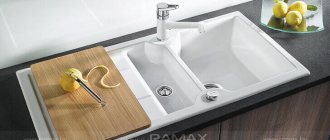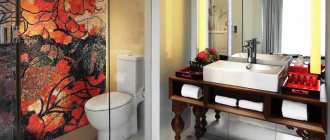Is the rug you're eyeing for your dining room suitable in size, shape and quality? Here's what you should keep in mind.
Finding a rug for the dining room that is both stylish and practical is not so easy. A carpet that is too fleecy will collect every crumb; a carpet that is too small will not allow chairs to be pulled out or pushed in freely. However, a good rug will add color and texture to your dining room, not to mention coziness and style, so it's well worth the effort to find the right rug. Read these ten tips to choose the perfect rug for that functional room.
More is better than less
The dining room rug should be at least 60cm larger than the dining table on each side so that guests can always pull out chairs without tripping over the edge of the rug. It is best if the carpet is even larger. To make sure the rug you choose will fit, measure your dining table, add 60cm (or more) to each side and mark the area for the rug on the floor with tape. If the boundaries of the marked area coincide with places where other furniture is located (buffet, serving table), consider rearranging the furniture.
Kitchen carpet size.
While size is an important factor when choosing any rug, it is especially important to consider for kitchen rugs.
Ideally, your kitchen rug should be large enough to accommodate a dining table and chairs. Moreover, even chairs moved away from the table with their back legs should still remain on the carpet.
When estimating the size of your rug, be sure to take into account the overall length of the table. This means you account for any form of table magnification used. Don’t forget to measure the kitchen itself, you need to see how the carpet will fit into it. Again, ideally, leave equal space on the sides. In addition to the table and chairs, take into account the sideboards or cabinets in the kitchen.
It is best to choose the size so that the rug ends just short of the front legs of the sideboard or cabinet, without going under it. Never place the front legs of furniture on carpet because this will affect its balance. If you must do this, balance the furniture by placing rubber or wood pads under the back legs.
Opt for a lint-free or short-pile carpet
Because spills and spills are inevitable, and the ability to move chairs around is important, lint-free or low-pile rugs are a very practical choice for a dining room. Leave shaggy, fleecy, soft Moroccan, and generally any carpets with long soft pile for the living room, where they will require much less care and cleaning.
Use the rug as a key decorative element
If the rug is one of your first purchases for the dining room, you can use it to set the overall tone of the interior and build a color scheme for the room based on it. Let the lightest (or background) shade of the rug be your wall color, and use the brighter shades of the pattern as accent shades for room décor items, like chair cushions or wall hangings.
Choose materials that are easy to clean
In general, natural materials such as wool or cotton are the easiest to clean, while synthetic ones are much more difficult in this regard. The exceptions are universal carpets, which are suitable for both interior and exterior, and stain-resistant cleaning carpets, which are made specifically to withstand frequent cleaning.
Carpets in the kitchen: bright accents!
Currently, one of the fashionable trends is to decorate kitchen interiors with beautiful carpets and rugs, which create a comfortable and homely atmosphere in them, and give the premises a more attractive and cozy appearance.
This solution has both its advantages and certain disadvantages. The advantages of such coverings include their pleasant soft surface, thanks to which you can walk on them barefoot even in the cold season. Using carpets in the kitchen is the best solution for families with small children, as they are not only warm, but can also protect the child from injury if he accidentally falls on the floor. In addition, carpets and small rugs look incredibly impressive in a room and can harmoniously fit into any interior style.
The disadvantages of these coatings include the fact that they wear out quite quickly and can even tear, since the kitchen has quite a lot of traffic. In addition, these products absorb all the dirt, grease and collect crumbs, and caring for them is much more difficult than other materials, such as ceramic tiles.
When choosing carpets, you should pay attention to such characteristics as resistance to various stains, as well as water-repellent properties. A practical solution would be carpets that are made of artificial material and, in addition, have a small pattern on which traces of dirt are not so noticeable. If desired, you can choose a compromise solution, for example, place a small rug near the dining table, and decorate the rest of the area using a more practical material.
DIY kitchen rug video:
Before purchasing carpet, you need to pay attention to the design solution in which the kitchen is made. In spacious rooms, large carpets will look most impressive. However, in this case, you need to be careful about the design of the coating and its colors, as it will attract quite a lot of attention. If the room is decorated in pastel colors and there are no bright and catchy details, then the flooring should also not have rich shades; a carpet of neutral tones will fit much more harmoniously into such a room.
In kitchens located on the south side, which are constantly illuminated by sunlight, carpeting in cold and dark shades will look elegant and noble. In a dark room, lit mainly only with artificial color, carpets in light pastel colors look harmonious.
Small rugs look no less attractive in the kitchen, giving it a warmer and more comfortable atmosphere, and in addition, protecting the floor from various damages and scratches. Kitchen rugs are a more practical solution than large rugs as they are easy to clean and can be washed in the washing machine if necessary. Designers recommend choosing kitchen coverings that have a non-slip surface, because it is difficult to slip on such products.
Typically, rugs are made from materials such as wool, polypropylene or nylon. These materials are wear-resistant, easy to maintain and resistant to moisture. These products come in a wide variety of designs. They can have an oval, rectangular or square shape, and also have different color combinations. The main thing is that they harmonize well with the design solution in which the room is made. For example, in classic kitchens, monochromatic coverings in light shades will look good, and in modern interiors, rugs with geometric patterns or products with images of plants, culinary dishes and animals.
Try using carpet tiles
These interlocking carpet squares can be laid in any way you want and cover any area you need. Plus, they come in a huge range of shades, textures and patterns. What makes carpet tiles a worthwhile choice for a dining room? If you get one square dirty, you can replace it with another rather than buying a whole new rug.
Advantages and disadvantages
Many people do not understand why a carpet is needed in the kitchen and refuse to use this element of the interior. However, a kitchen mat has certain advantages:
- perfectly performs the function of zoning and allows you to visually expand the space. Also, a kitchen rug on the floor separates the dining area from the working area, which is very convenient in large rooms;
- such a covering is indispensable if small children live in the apartment, as it will help soften the fall. The presence of a rug is especially important if the room is tiled;
- a small rug near the table will help relieve the load on your feet, which will be indispensable for housewives who spend a lot of time at the stove;
- The carpet protects the floor covering from scratches and chips.
In addition, a carpet can refresh the kitchen and add originality to the design. Some rugs can also focus attention on individual interior elements (especially if they match the color scheme).
As for the disadvantages of this solution, they include:
- increased likelihood of contamination. Dirt will accumulate not only on the rug, but also under it;
- cleaning the premises will become more problematic and time-consuming;
- rapid wear. As practice shows, kitchen carpets lose their attractive appearance much faster, which is partly due to the need for frequent cleaning and washing.
On a note! A kitchen rug must be rubberized on the back side. This will help prevent slipping on the floor covering.
Feel a natural carpet before purchasing
Carpets made from natural materials, including sisal, jute and matting, have many advantages, such as reasonable price, wonderful texture and classic look. But while cotton and wool are fairly easy to clean, these materials can be more difficult to clean. The key to solving the problem lies in the texture of the carpet - the finer and smoother it is, the easier it is to clean. On the other hand, cleaning a carpet with a dense, coarse weave of food that has soaked into it can be nearly impossible. Consider this a warning.
Kitchen carpet material.
There will be heavy pieces of furniture on the kitchen carpet, and so will you. Chairs will be put out and put back. You may drop food, and even if you don't spill anything, there will still be crumbs. Your budget will also play a significant role in the choice of material.
When protecting your kitchen rug from wear and tear, choose a material that is easy to clean and can be used for a long time. If you want to use natural materials, avoid silk or cotton rugs as they are not very suitable for kitchens. Wool is good, but it is an expensive material.
Man-made fiber carpets are easy to clean and maintain.











